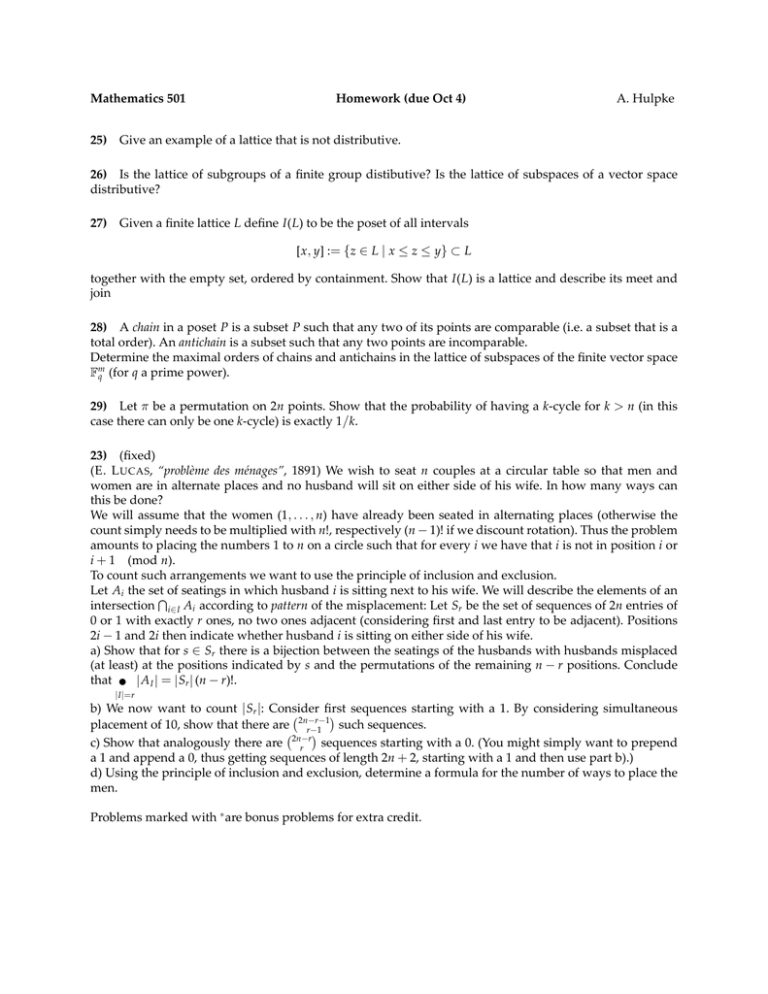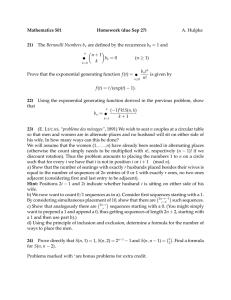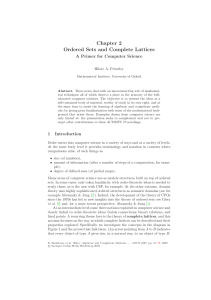Mathematics 501 Homework (due Oct 4) 25) 26)
advertisement

Mathematics 501
Homework (due Oct 4)
A. Hulpke
25) Give an example of a lattice that is not distributive.
26) Is the lattice of subgroups of a finite group distibutive? Is the lattice of subspaces of a vector space
distributive?
27) Given a finite lattice L define I(L) to be the poset of all intervals
[x, y] := {z ∈ L | x ≤ z ≤ y} ⊂ L
together with the empty set, ordered by containment. Show that I(L) is a lattice and describe its meet and
join
28) A chain in a poset P is a subset P such that any two of its points are comparable (i.e. a subset that is a
total order). An antichain is a subset such that any two points are incomparable.
Determine the maximal orders of chains and antichains in the lattice of subspaces of the finite vector space
Fm
q (for q a prime power).
29) Let π be a permutation on 2n points. Show that the probability of having a k-cycle for k > n (in this
case there can only be one k-cycle) is exactly 1/k.
23) (fixed)
(E. L UCAS, “problème des ménages”, 1891) We wish to seat n couples at a circular table so that men and
women are in alternate places and no husband will sit on either side of his wife. In how many ways can
this be done?
We will assume that the women (1, . . . , n) have already been seated in alternating places (otherwise the
count simply needs to be multiplied with n!, respectively (n − 1)! if we discount rotation). Thus the problem
amounts to placing the numbers 1 to n on a circle such that for every i we have that i is not in position i or
i + 1 (mod n).
To count such arrangements we want to use the principle of inclusion and exclusion.
Let Ai the setTof seatings in which husband i is sitting next to his wife. We will describe the elements of an
intersection i∈ I Ai according to pattern of the misplacement: Let Sr be the set of sequences of 2n entries of
0 or 1 with exactly r ones, no two ones adjacent (considering first and last entry to be adjacent). Positions
2i − 1 and 2i then indicate whether husband i is sitting on either side of his wife.
a) Show that for s ∈ Sr there is a bijection between the seatings of the husbands with husbands misplaced
(at least) at the positions indicated by s and the permutations of the remaining n − r positions. Conclude
that ∑ | A I | = | Sr | (n − r)!.
| I |=r
b) We now want to count | Sr |: Consider first
sequences starting with a 1. By considering simultaneous
placement of 10, show that there are 2nr−−r1−1 such sequences.
c) Show that analogously there are 2nr−r sequences starting with a 0. (You might simply want to prepend
a 1 and append a 0, thus getting sequences of length 2n + 2, starting with a 1 and then use part b).)
d) Using the principle of inclusion and exclusion, determine a formula for the number of ways to place the
men.
Problems marked with ∗ are bonus problems for extra credit.






